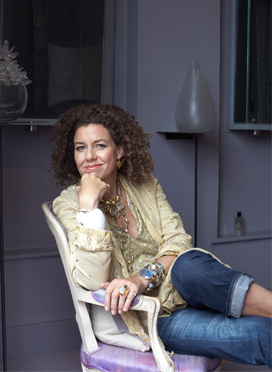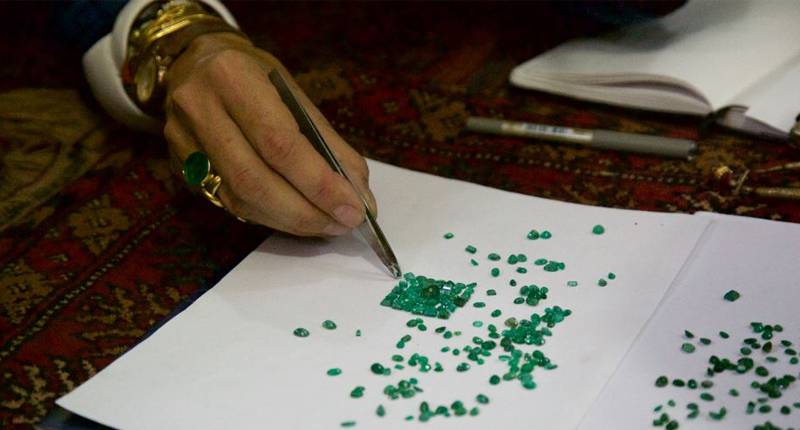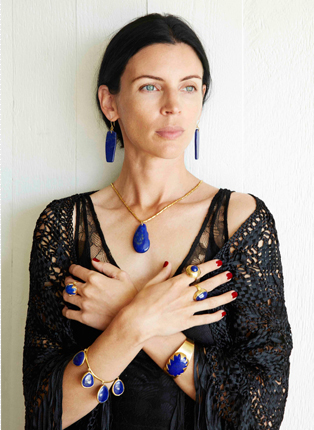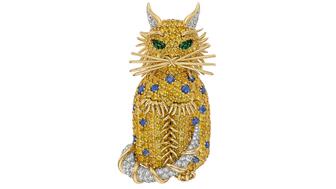Need a gift for the cat lover who has everything? Look no further than our latest Piece of the Week.
How Pippa Small is Helping Afghan Artisans
An official partner of the organization Turquoise Mountain, Small is dedicated to empowering her fellow jewelers in beleaguered Afghanistan.
The more e-mails I receive, the more I come to the conclusion that design and philanthropy are members of a tricky partnership.
At times, it can be difficult to ascertain whether a company is dedicated to aligning their business with a cause, or if they’re simply participating in a self-benefiting marketing ploy.
More detrimental still can be the companies that donate funds to unsustainable ventures. It goes back to the proverb “give a man a fish.” If you teach him to fish, he’ll be self-sufficient for a lifetime. It’s an old saying, but one that remains difficult to embody.

I knew of London-based jewelry designer Pippa Small because of her eye for vividly colored gemstones and the easy, organic quality of her jewelry.
It was only when I met her for the first time, at the opening of her shop-in-shop at ABC Carpet & Home in New York, that I learned about her many years of work with Turquoise Mountain, an organization founded in 2006 by the Prince of Wales and Hamid Karzai, then the president of Afghanistan.
Turquoise Mountain has worked to rebuild infrastructure and provide vocational training to Afghan artisans in Kabul.
Small has been working with the organization, helping design, market and sell pieces so artisans can earn a living on the way to self-sufficiency, since 2008.
She is, essentially, dedicating her life to teaching people how to fish.
Below, I chatted with the exemplary designer about her connection to Afghanistan, life in a warzone and the moments that have inspired her.
National Jeweler: When and how did you become involved with Turquoise Mountain?
Pippa Small: In 2008, I was approached by a mutual friend to design a collection of jewelry in Afghanistan to compliment a touring exhibition of the famous “Bactrian Gold,” a remarkable collection of antiquities found in what is now Afghanistan: treasures gathered from the famous Silk Routes of Central Asia, from second-century Greece and Rome to China and India. The trade of goods, materials and design aesthetics was extraordinary. I said yes before she had even finished explaining the proposal.
My best friend in school when I was 10 years old was an Afghan girl whose grandfather was the last king of Afghanistan--I had a childhood filled with tales of this mysterious country and, like the rest of the world, watched in horror as the Taliban took over and the recent wars.
Within two weeks I had a visa, a letter of invitation and was on a plane for Kabul. From the moment I landed, I loved the country and over the following few years, every trip has taken me a step deeper and into understanding this remarkable culture and people.
“Within two weeks I had a visa, a letter of invitation and was on a plane for Kabul.”
Turquoise Mountain is a wonderful foundation that has managed to achieve so much in a short space of time, from beautifully restoring the historic old city’s architecture and creating an infrastructure, health clinic and school, as well as a school for traditional craft like woodwork, miniature painting, calligraphy and jewelry. I am so proud to be working with them.
NJ: How would you describe your role within the organization?
PS: My role is to create designs with the workshops where the graduates from the Turquoise Mountain school are hired. The designs are inspired by Bactrian, Islamic or Central Asian aesthetics. My job is also to market them and thereby ensure employment for the craftsmen and women (as well as) to send another kind of message to the media and our clients about the remarkable creative resilience of these people, giving an optimistic message for the future.
NJ: How often do you visit Kabul and what is it like on the ground, working directly with the artisans?
PS: I go about twice a year and, despite some trepidation about going, once I am inside the workshop, the rest of the world is blocked out.
We sit on the floor and talk about designs, but more importantly about life and love and politics and the stresses of living in a war zone. They are brave and warm and have totally captured my heart.
NJ: Can you speak a bit about the kind of art and jewelry the artisans at Turquoise Mountain create or what kind of techniques Turquoise Mountain is trying to keep alive?
PS: Because of the nearly 50 years of war and the huge diaspora of people and the Taliban’s banning of jewelry and adornment, many traditional techniques and skills were on the verge of being lost.
A prime example is the story of a master woodcarver who worked with the king and was a deeply talented craftsman. He was found working in the vegetable market in his 80s--he is now a master teacher at the school, teaching and passing on his skills to a new generation of young wood workers.
Afghanistan has some beautiful precious gems, but so many are smuggled out of the country with no benefit to the country, so now the teaching of master stone cutting and goldsmithing allows finished pieces to be sold from within the country, which adds value to Afghanistan.
NJ: What challenges have you encountered in your work with the organization?
PS: Bombs that have damaged the workshop, thefts of entire collections of jewelry, kidnapping, election violence … but despite so many challenges, the craftsmen and women always get the work done.
NJ: How do you help to facilitate a sustainable vocation for the artists with whom you work? Is this a challenge and if so, how?
PS: It is a challenge to keep anything sustainable in the fashion world by the very nature of the vogue for change and our thirst for newness, but by keeping the designs fresh and exploring different techniques, I hope to keep a loyal and growing audience.

NJ: Are there any specific moments or memories you have that stand out to you as significant or inspiring?
PS: Working with a young Afghan woman who was left deaf and mute from a childhood illness as a refugee in Pakistan. Encouraged by her family, she joined the jewelry-making course at the Turquoise Mountain Institute and then set up a cooperative of women jewelers in Kabul.
We were asked by Turquoise Mountain to collaborate on a piece of jewelry for the prestigious Smithsonian Exhibition for Turquoise Mountain this year. I found it remarkable that a young woman locked in her silent world would enter a male-dominated industry, and be brave enough to follow her dreams and be creative in a country at war.
We created a piece together that is based on an ancient amulet, made of Panjshiri emeralds [from the Panjshir Valley in Afghanistan] and inspired by the movement of rain--so important in a desert place.
Behind the necklace we created a tiny hidden gold box with a pinch of Afghan soil inside. She is an inspiring young woman and has since gone to Washington to display her jewelry-making skills at the Smithsonian museum.
“I found it remarkable that a young women locked in her silent world would enter a male dominated industry, and be brave enough to follow her dreams and be creative in a country at war.”
NJ: Over your time with Turquoise Mountain how has the environment in Kabul changed? Has it improved? Are there any increasing or new challenges to deal with in the social environment?
PS: In the years I have been going, sadly, the security situation in Kabul has deteriorated; there has been an economic collapse in the city as foreign troops, NGOs and the press pull out. It is very sad to see a country have a moment where things looked positive and then slowly to see that fall apart and young people not have hope for the future.
I worry that if we don’t help to provide jobs, groups like ISIS and Taliban will be the only option for the young and disillusioned.

NJ: What advice do you have to those interested in empowering others through the business and crafting of jewelry?
PS: I think jewelry making and all creative businesses can have a tremendously positive impact on communities. Craft is generally something all peoples practice to some extent everywhere in the world, to be creative and make things, to be able to use traditional skills that help create a feeling of self-confidence, a business that allows men and women to stay in the community and not have to migrate for work, that allows self-expression and earns an income is a great and empowering thing.
I think keeping expectations realistic is important when working with communities, sharing your design process so designing can become something for others to learn, keeping a good business head on when it comes to margins and mark-ups so the pieces will eventually be realistically marketable.
Pieces from Pippa Small Turquoise Mountain are available on PippaSmall.com.
The Latest

It purchased the “Grosse Pièce,” an ultra-complicated Audemars Piguet pocket watch from the ‘20s, for a record-breaking price at Sotheby’s.

Sponsored by Digital Monitoring Products

How Jewelers of America’s 20 Under 40 are leading to ensure a brighter future for the jewelry industry.

The boutique is slated to open this week inside Terminal 8, offering pre-owned Rolex watches and more to international travelers.


The lab-grown diamond grower now offers custom engagement and fashion jewelry through its Kira Custom Lab Jewelry service.

The special-edition egg pendant ingested in a New Zealand jewelry store was recovered after a six-day wait.

Roseco’s 704-page catalog showcases new lab-grown diamonds, findings, tools & more—available in print or interactive digital editions.

The “Love and Desire” campaign is inspired by the magic that follows when one’s heart leads the way, said the brand.

Two awardees will receive free tuition for an educational course at the Swiss lab, with flights and lodging included.

Berta de Pablos-Barbier will replace Alexander Lacik at the start of January, two months earlier than expected.

Sotheby’s held its first two jewelry sales at the Breuer building last week, and they totaled nearly $44 million.

Winners will receive free registration and lodging for its fourth annual event in Detroit.

Here are six ideas for making more engaging content for Instagram Reels and TikTok, courtesy of Duvall O’Steen and Jen Cullen Williams.

The honorees include a notable jewelry brand, an industry veteran, and an independent retailer.

Carlos Jose Hernandez and Joshua Zuazo were sentenced to life without the possibility of parole in the 2024 murder of Hussein “Sam” Murray.

Yood will serve alongside Eduard Stefanescu, the sustainability manager for C.Hafner, a precious metals refiner in Germany.

The New Orleans jeweler is also hosting pop-up jewelry boutiques in New York City and Dallas.

Set in a Tiffany & Co. necklace, it sold for $4.2 million, the highest price and price per carat paid for a Paraíba tourmaline at auction.

The jeweler’s “Deep Freeze” display showcases its iconic jewelry designs frozen in a vintage icebox.

Take luxury gifting to new heights this holiday season with the jeweler’s showstopping 12-carat sphene ring.

This year's theme is “Unveiling the Depths of the Ocean.”

In its annual report, Pinterest noted an increase in searches for brooches, heirloom jewelry, and ‘80s luxury.

Starting Jan. 1, customers can request the service for opal, peridot, and demantoid garnet.

The 111-year-old retailer celebrated the opening of its new location in Salem, New Hampshire, which is its third store in the state.

The new catalog features its most popular chains as well as new styles.

The filmmaker’s personal F.P. Journe “FFC” prototype was the star of Phillips’ recent record-setting watch auction in New York.
































